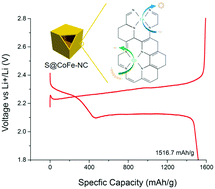A N-Rich porous carbon nanocube anchored with Co/Fe dual atoms: an efficient bifunctional catalytic host for Li–S batteries†
Abstract
Although lithium–sulfur batteries have attracted increasing attention due to their high specific energy and low cost of electrode materials, their practical use is hindered by unfavorable electrochemical shuttling and sluggish conversion of polysulfides. In this work, we reported a nitrogen-rich porous carbon nanotube as the host material for the S cathode. Derived from metal organic frameworks, the carbon host was anchored with isolated cobalt/iron dual atoms, which acted as an efficient electrocatalyst to trigger the surface-mediated reaction of polysulfides. During the discharge–charge cycle of Li–S batteries, the Co/Fe sites work as a bifunctional electrocatalyst to facilitate reversible conversion reaction between S and Li2S. With a high S mass ratio of 72 wt%, S@C composites prepared from the above carbon host are able to deliver a high specific capacity of 1516 mA h g−1 at 0.1C and improved cycling stability (a low capacity decay of 0.08% per cycle after 300 cycles at 0.5C). This work demonstrates a rational strategy to boost the storage performance of the S cathode in rechargeable Li–S batteries.



 Please wait while we load your content...
Please wait while we load your content...